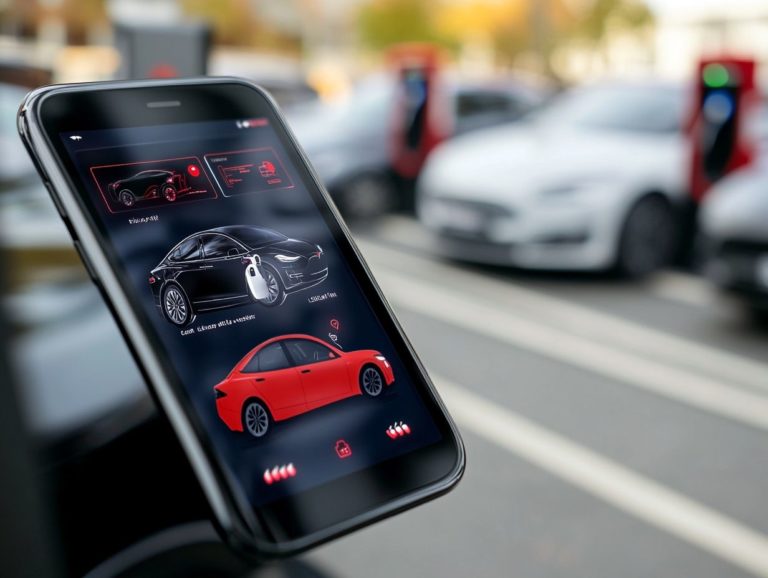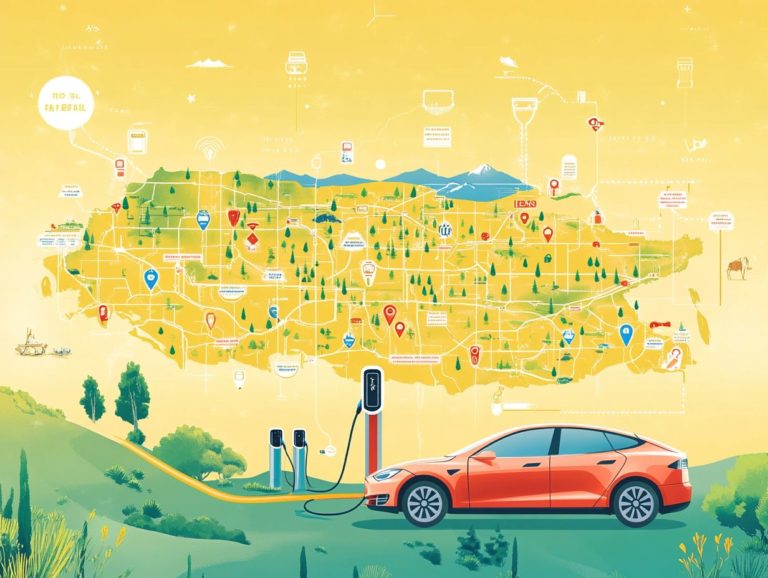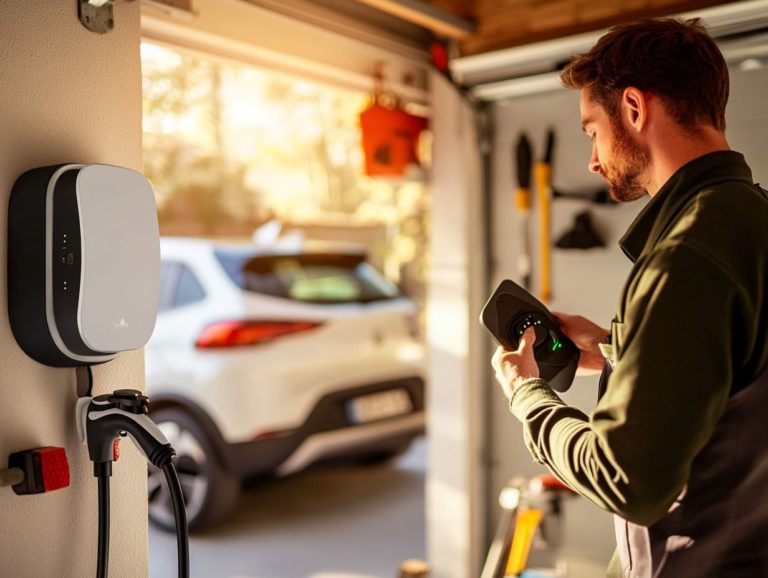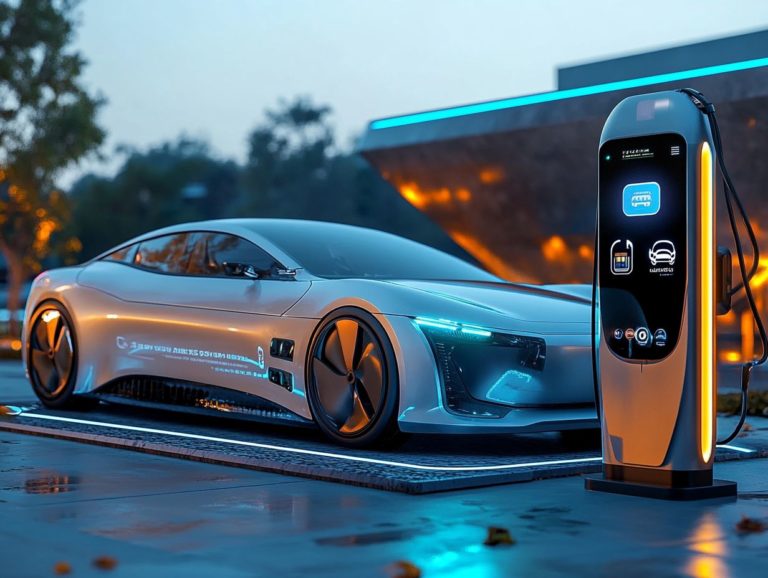How Do Charging Stations Impact the Grid?
Electric vehicle (EV) charging stations are becoming increasingly common, prompting important questions about their influence on the electrical grid.
As you consider making the transition to electric vehicles, it’s essential to grasp how these charging hubs affect electricity demand, grid infrastructure, and overall stability.
This article delves into the challenges and benefits of integrating charging stations into our energy systems. We showcase innovative solutions and the potential for a greener future through renewable energy integration.
Explore this dynamic landscape with us and discover what the future holds for charging stations and the grid.
Contents
- Key Takeaways:
- Impact of Charging Stations on the Grid
- Benefits of Charging Stations for the Grid
- Challenges and Solutions for Grid Integration
- The Bright Future of Charging Stations and the Power Grid
- Frequently Asked Questions
- How do charging stations affect the grid’s electricity demand?
- Do charging stations pose a threat to the stability of the grid?
- Can charging stations help with grid modernization and sustainability?
- Are there any potential benefits to the grid from charging stations?
- How can the grid handle the increased load from a growing number of charging stations?
- What role do regulations play in managing the impact of charging stations on the grid?
Key Takeaways:
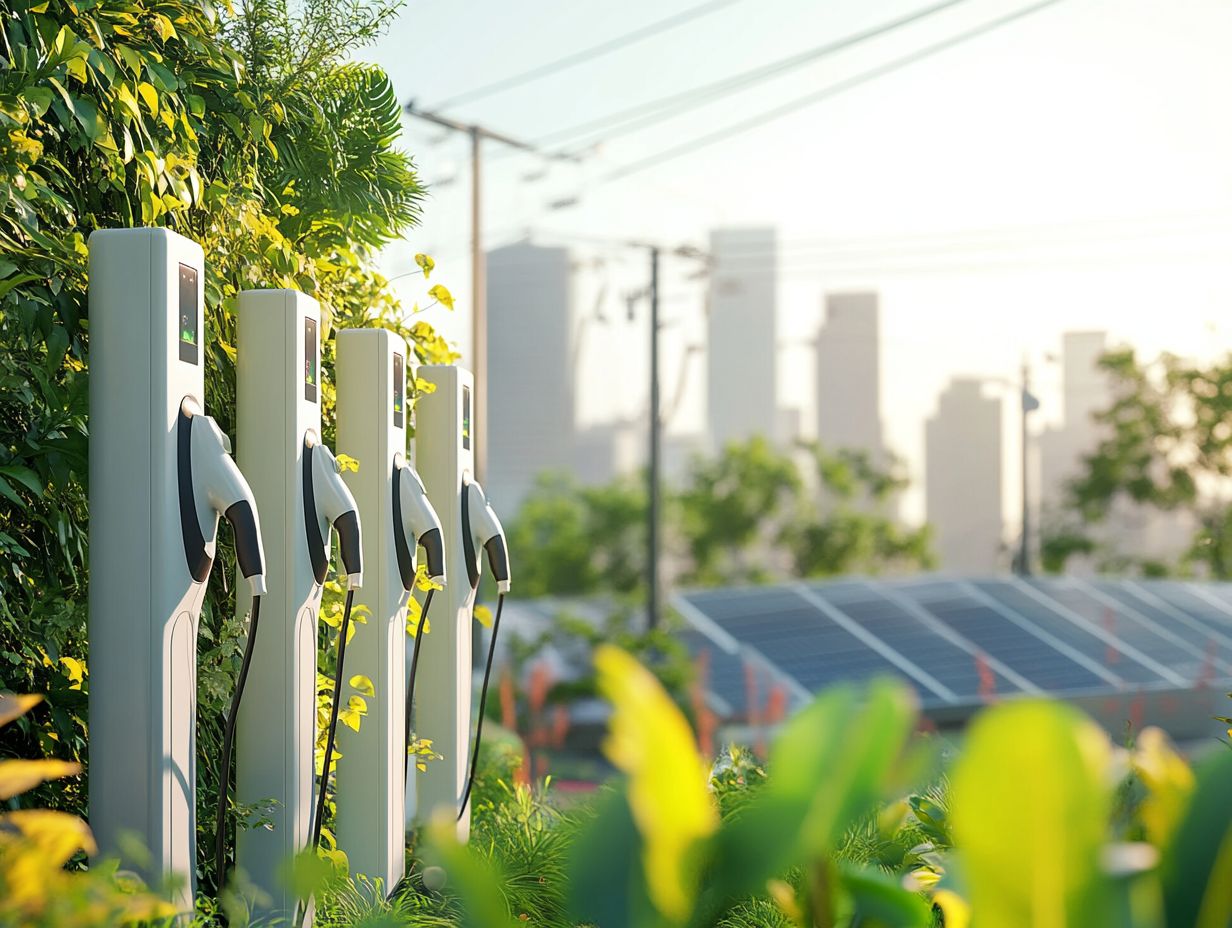
- Charging stations increase demand on the grid but can also improve grid stability and reduce carbon emissions.
- The grid faces challenges with peak demand and infrastructure; smart charging technologies and renewable energy integration offer potential solutions.
- As electric vehicle adoption increases, charging stations will support renewable energy and create a more sustainable future for the grid.
Overview of Electric Vehicle Charging
Electric vehicle charging is a pivotal element in the energy transition, enabling you to embrace electric vehicles (EVs) while meeting the rising demand for clean energy solutions.
As the transportation landscape shifts toward electric options, establishing a robust network of charging stations becomes essential.
This infrastructure facilitates home and workplace charging and includes public charging stations, crucial for long-distance travel.
By understanding various charging technologies and user behaviors, you can optimize energy consumption and enhance overall efficiency in the electric vehicle market.
Home charging solutions allow you to wake up each day with a fully charged battery, ready to go. Public charging stations, placed in urban centers and along highways, ensure you can recharge during trips, putting an end to range anxiety.
Workplace charging options are significant for you as a commuter, encouraging electric vehicle use by providing charging opportunities during work hours.
The expansion of these networks is vital for boosting EV adoption, aligning perfectly with broader energy policies aimed at reducing carbon emissions and achieving sustainability goals.
By investing in these infrastructures, cities and governments create an environment nurturing clean energy innovations, ultimately benefiting you and the planet.
Impact of Charging Stations on the Grid
The growing number of charging stations significantly influences electricity demand and raises questions about how electric vehicles impact the power grid.
Strategic grid management and upgrades are essential to handle rising energy consumption.
With electric vehicle sales on the upswing, it’s increasingly crucial to understand the connection between charging stations and the electrical grid.
This integration directly impacts electricity generation, ways to manage electricity use, and the efficiency of energy resources.
We need better grid services to keep up with future charging demands effectively.
Ready to learn more about electric vehicles and the future of charging stations? Join us in exploring and supporting clean energy initiatives!
Increased Demand for Electricity
The rising popularity of electric vehicles (EVs) is driving a significant surge in electricity demand, creating challenges for managing the grid and energy consumption patterns.
As you transition to electric vehicles, you may notice this increase in electricity usage leading to substantial peak loads. This necessitates careful planning and management of energy resources.
Tackling this challenge is crucial to ensuring the reliability and efficiency of the electrical grid while fostering the widespread adoption of EVs.
The expansion of EVs is also reshaping consumption behavior, as charging typically occurs during the evening when demand and rates peak. This calls for exciting new solutions to meet our energy demands!
Integrating renewable energy sources like solar and wind can alleviate grid pressure by providing cleaner alternatives to meet these heightened demands.
With projections indicating that global EV sales are set to double within the next five years, we must act now on efficient energy management!
Key strategies, including smart technology for the power grid and energy storage systems, will be essential in overcoming these challenges and enhancing overall energy efficiency.
Effects on Grid Infrastructure
Charging stations have a profound impact on grid infrastructure, requiring essential upgrades and adaptations to handle increased loads while ensuring efficient energy distribution. Understanding the environmental impact of EV charging stations is also crucial for sustainable development.
As EV usage surges, older components like transformers may face accelerated aging due to heightened electricity demand.
It becomes vital for you to use modern charging technologies and energy storage solutions to stabilize the grid and enhance overall performance.
This added pressure underscores the immediate need for utilities to evaluate their infrastructure, particularly focusing on outdated transformers that may struggle to accommodate the rising energy flows effectively.
Upgrading these critical components isn’t just about modernization; it s essential for maintaining grid reliability and preventing outages.
Incorporating energy storage systems can be a game-changer in balancing supply and demand.
This allows for excess energy generated during off-peak hours to be stored and released during peak usage times.
Such enhancements not only strengthen the grid’s resilience in the face of escalating electrical demands but also foster a more sustainable energy ecosystem.
Benefits of Charging Stations for the Grid
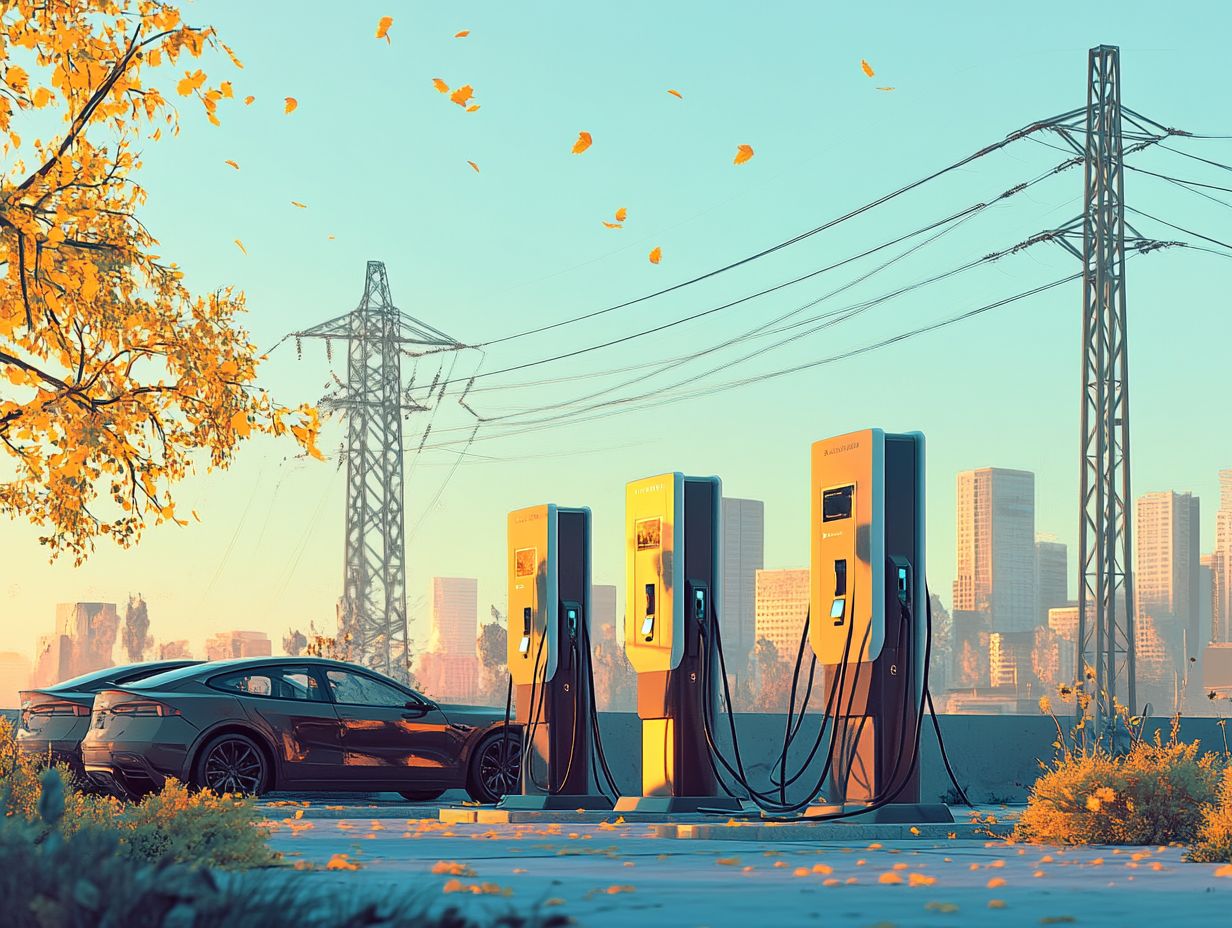
Charging stations provide a wealth of benefits for the grid, especially when it comes to promoting clean energy, enhancing grid stability, and reducing carbon emissions.
By encouraging the adoption of electric vehicles (EVs), these stations play a crucial role in the transition to renewable energy sources, significantly minimizing environmental impact.
Additionally, their thoughtful placement can boost energy efficiency throughout the power grid, offering the dual advantage of supporting electric vehicle usage while simultaneously improving overall grid performance.
Reduced Carbon Emissions
Integrating charging stations plays a crucial role in reducing carbon emissions, aligning perfectly with global efforts to combat climate change.
As you, like many consumers, opt for EVs, your shift from fossil fuels to clean energy can dramatically cut greenhouse gas emissions, paving the way for a more sustainable future.
In urban and suburban settings, having accessible charging infrastructure not only encourages you to adopt EVs but also enables you to harness solar and wind energy.
This allows you to power your vehicle with resources that are both abundant and clean.
Statistics reveal that cities boasting extensive charging networks have experienced a remarkable 25% reduction in CO2 emissions over the past five years.
Take Los Angeles, for instance; with over 2,000 charging stations added, the city has seen a 15% increase in EV usage, resulting in a significant decline in air pollutants.
These trends highlight how charging stations serve as a pivotal link in your journey toward greener transportation solutions.
Improved Grid Stability
Charging stations can elevate grid stability. They do this by using advanced charging technology and innovative energy storage solutions to balance supply and demand in real-time.
As your electric vehicle (EV) charging habits evolve, integrating demand response capabilities the ability to adjust electricity usage based on supply availability can help you manage fluctuations in electricity demand. This fosters a more resilient and reliable electrical grid.
By strategically managing your charging times and rates, you can take advantage of initiatives that allow you to charge your vehicle during off-peak hours. This alleviates strain on the grid during peak demand periods.
Energy storage systems serve as effective buffers. They capture surplus energy generated from renewable sources and release it when necessary. This ensures a seamless alignment of supply with consumption.
More users engaging in these programs strengthens the connection between transportation and energy production systems. This results in enhanced grid performance and facilitates a smoother transition toward sustainable energy solutions.
Challenges and Solutions for Grid Integration
Integrating charging stations into the existing power grid poses intriguing challenges. These include peak demand management and understanding charging behaviors and patterns.
As electric vehicles (EVs) gain traction, utilities must navigate the complexities of maintaining grid integrity while accommodating the variable demand created by diverse charging scenarios.
By implementing managed charging strategies, you can alleviate stress on grid resources during peak periods and enhance overall efficiency.
Managing Peak Demand
Managing peak demand is essential for maintaining grid reliability, especially with the rise of electric vehicles (EVs) and their increasing electricity consumption.
As the demand for charging grows, you may encounter challenges in keeping electricity prices stable and ensuring there s enough supply during peak times. Effective demand response strategies and managed charging protocols help address these challenges.
By leveraging real-time data and encouraging consumer participation, utilities can introduce dynamic pricing models. These motivate you to shift your electricity use to off-peak hours, bolstering grid reliability and stabilizing prices for everyone.
Managed charging solutions can optimize your EV’s charging patterns. This allows you to charge during off-peak periods or when renewable energy sources are abundant.
These strategies create a win-win scenario, promoting a sustainable energy ecosystem while enabling you to make informed decisions about your electricity consumption.
Implementing Smart Charging Technologies

Implementing smart charging technologies is crucial for optimizing your charging behavior and enhancing grid management as electric vehicles (EVs) become increasingly prevalent.
By leveraging data collection and analysis, utilities can gain valuable insights into your charging patterns. This allows them to make informed decisions that improve efficiency across charging networks.
These technologies aid in balancing electricity demand and facilitate the integration of renewable energy sources.
As you navigate the roads with an ever-growing number of EVs, the pressure on the existing electrical infrastructure is poised to escalate.
Smart charging can play a pivotal role in alleviating this potential strain. It aligns your charging schedules with times of low demand or peak renewable energy generation. This synchronization ensures that power sources like solar and wind are utilized effectively, reducing reliance on fossil fuels.
By harnessing data insights, utilities can devise targeted strategies for resource allocation that adapt to fluctuations in usage. This mitigates the repeated strain on certain sections of the grid, paving the way for a more resilient and sustainable energy system overall.
Join the movement towards a sustainable energy future. Start optimizing your EV charging habits today!
The Bright Future of Charging Stations and the Power Grid
The future of charging stations and our power grid is bright and full of potential. Anticipated advancements in combining clean energy sources and the growing adoption of electric vehicles (EVs) are set to drive significant transformations in the energy landscape.
As the electric vehicle market expands, the need for efficient charging infrastructure will increase. This paves the way for an energy transition that prioritizes sustainability and clean energy solutions. These developments will enhance your experience as a consumer and contribute to a more resilient and efficient power grid for everyone.
Potential for Clean Energy Integration
The potential for integrating renewable energy into charging stations is immense. This offers significant opportunities for the electric vehicle (EV) market to optimize clean energy use. By incorporating energy storage solutions alongside charging infrastructure, you can manage electricity supply from renewable sources more effectively.
This approach reduces reliance on fossil fuels and promotes sustainability within the transportation sector. Charging stations outfitted with cutting-edge battery technology can serve as dynamic hubs, absorbing excess energy generated during peak solar or wind production periods.
This strategy alleviates strain on the grid and ensures your electric vehicles are charged with the cleanest energy available. Balancing supply and demand through energy storage systems can significantly minimize the environmental impact of charging.
As the EV ecosystem continues to develop, integrating renewable resources at charging hubs offers a promising pathway toward a more sustainable future, addressing both consumer needs and ecological aspirations.
Charging Stations and Electric Vehicle Adoption
Charging stations are essential for driving electric vehicle adoption. They provide the vital infrastructure needed to support the expanding EV market and facilitate the shift toward clean energy. By making charging accessible and convenient, these stations encourage you to consider switching to electric vehicles.
As more charging stations emerge in both urban and rural areas, you can travel confidently without the fear of running out of power. This convenience instills a sense of reliability and positions electric vehicles as a practical choice for daily commutes and long-distance journeys.
By strengthening the charging infrastructure, stakeholders can effectively shape consumer behavior, paving the way for greater acceptance of electric vehicles. This transition could ignite accelerated growth in the market, prompting manufacturers to innovate and broaden their offerings to meet diverse driving needs.
Frequently Asked Questions
How do charging stations affect the grid’s electricity demand?
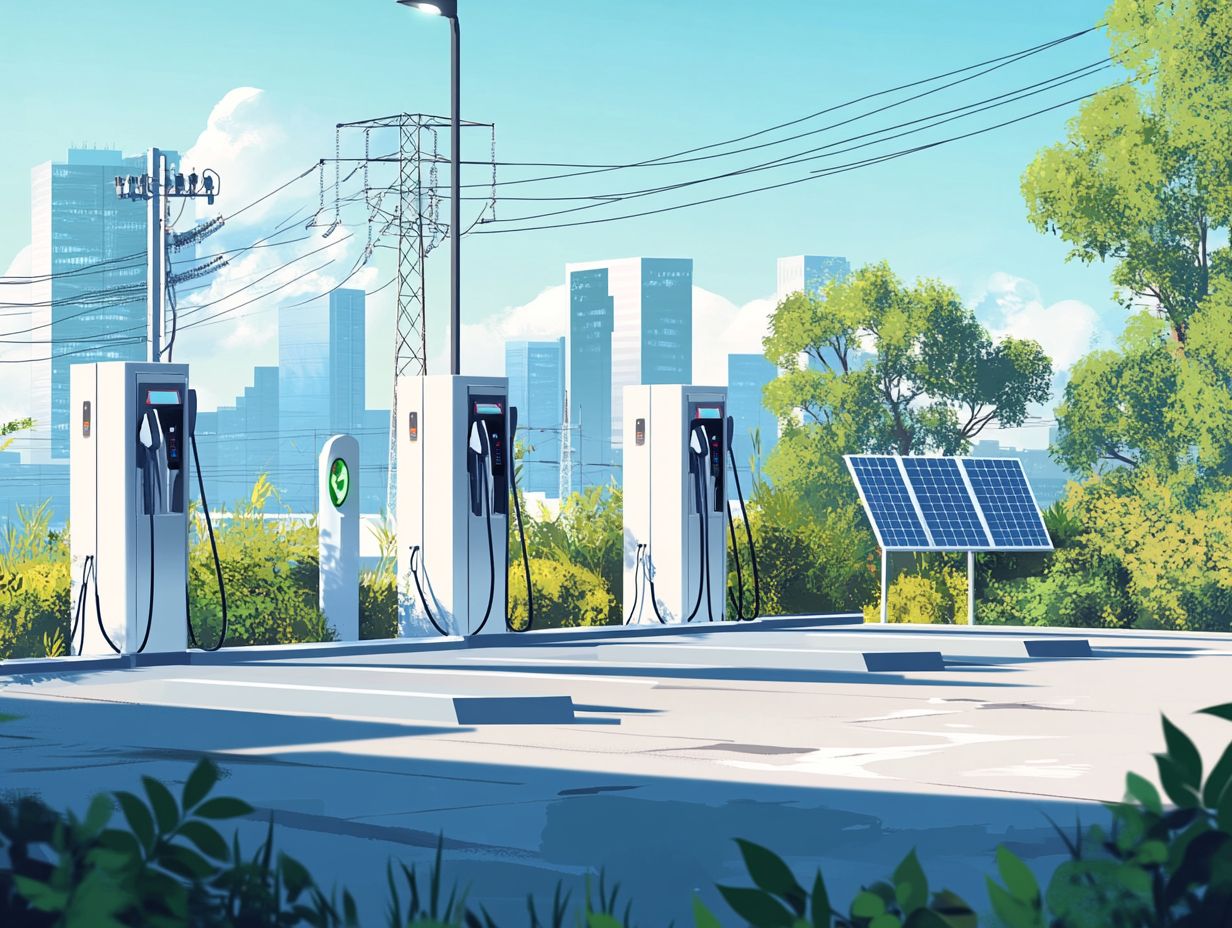
Charging stations can increase the grid’s electricity demand during peak charging times. This may require utilities to adjust their power generation and distribution strategies, highlighting the importance of understanding the environmental impact of EV charging.
Do charging stations pose a threat to the stability of the grid?
If not managed properly, charging stations can overload the grid’s capacity and cause power outages. However, advancements in smart grid technology and the role of charging stations in EV ecosystems can help mitigate this risk.
Can charging stations help with grid modernization and sustainability?
Yes, charging stations can support grid modernization efforts by promoting the use of renewable energy sources and reducing carbon emissions from transportation.
Are there any potential benefits to the grid from charging stations?
Charging stations can provide a new source of revenue for utilities and help balance the grid’s load by charging electric vehicles during off-peak hours.
How can the grid handle the increased load from a growing number of charging stations?
To accommodate the growing demand for charging stations, utilities may need to invest in upgrading and expanding their infrastructure. This includes installing new transmission lines and implementing smart grid technologies.
Stay tuned for more updates on how charging stations are transforming our energy landscape!
What role do regulations play in managing the impact of charging stations on the grid?
Regulations and policies are essential for the proper installation and management of charging stations. They help ensure that these stations do not disrupt the grid’s stability or efficiency.
By following these rules, we can support a reliable energy system while promoting the use of electric vehicles. Understanding these regulations is crucial as we move toward a greener future.

